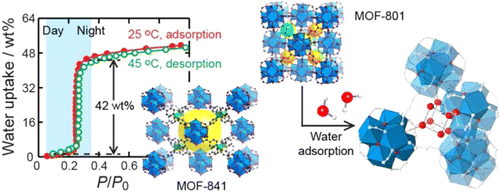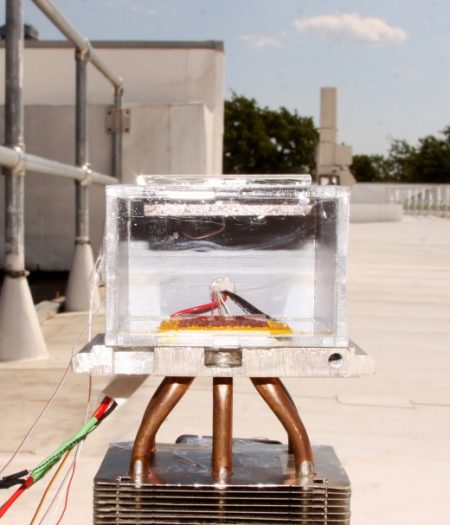August 5, 2017 – Back in April of this year an article appeared in the journal Science entitled, “Water harvesting from air with metal-organic frameworks powered by natural sunlight.” It described the discovery of a technology capable of harvesting water using only the energy from ambient sunlight interacting with a porous metal-organic framework. The technology produced 2.8 liters of freshwater per kilogram of material per 12 hours even when humidity levels dropped as low as 20%.
The research was undertaken by scientists and engineers from Massachusetts Institute of Technology, UC Berkeley, the Lawrence Berkeley National Laboratory, and King Abdulaziz City for Science and Technology, the latter in Riyadh, Saudi Arabia. The metal-organic framework, or MOF, is a sponge-like material capable of chemical vapour deposition in low humidity. The material is porous with each grain filled with holes allowing for the trapping of gasses from even the most eye-drying air (think the Sahara Desert). The trapped water vapour is heated by sunlight and passes into a chamber where it makes contact with a condenser plate turning water from a gaseous to a liquid state. Seen below, the prototype device represents what may become the ideal solution for a significant number of people facing a daily fresh water crisis.
Just how big is the fresh water crisis?
According to an article published last year in Science Advances, the number of people living in freshwater scarce areas of the planet approaches 4.3 billion today. That’s more than two-thirds of us here on Earth living in places like the Middle East, Australia, Central Asia, the Indian subcontinent, China, much of Africa, southwestern United States, and parts of Central and South America.
In the United States today the Colorado River has become the primary source of fresh water for much of the southwest including California, and the river, as I have described in previous postings, is in serious danger of drying up.
The largest number of people impacted include:
- 1 billion in India
- 0.9 billion in China
- 130 million in both Bangladesh and the United States
- 120 million in Pakistan
- 110 million in Nigeria
- 90 million in Mexico.
Of these, 1.8 to 2.9 billion face severe fresh water scarcity 4 to 6 months every year. That’s why a harvester that grabs water from air, currently an underutilized source that represents 13,00o trillion liters or 10% of all fresh water on Earth, should be a high priority. And when you add the fact that the technology requires sunlight only, no other energy source, it seems like a no brainer. So how close are the inventors to a product that can be mass produced?
The water harvester requires two particular water adsorptive MOFs (see illustration below). Both contain zirconium. BASF, in Germany, is currently the world’s largest supplier. And according to the inventors, it shouldn’t be difficult to scale up production.

The implications for the Developing World, and in particular, its children, can be enormous. Why? From a press release published at the close of the 4th World Water Forum in Mexico City in 2006, it noted that 400 million children at that time were at risk because of unsafe water. That’s because children are the family members often sent on the daily search for fresh water for household use. These journeys take the children from school for much of the day which impacts their education, and their future potential to rise out of poverty. Combine that with the threat of disease from the water they do bring back, often containing pathogens, and you have a toxic situation. Stated Dolly Akhter, a hygiene educator in Bangladesh who attended the Mexico City event, “where I live, many children are out of school because of diseases they catch from their drinking water.”
Omar Yaghi of UC Berkeley, one of the water harvester creators, upon realizing what they had invented stated, “We have to get this out.” He’s absolutely right. This could be a game changer for the planet.









